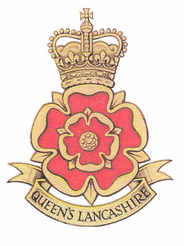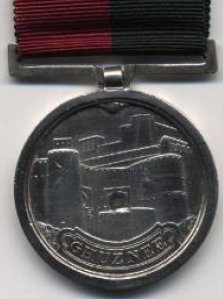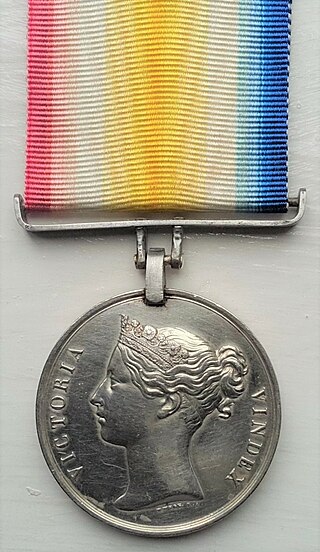18th century
-
 Naval Gold Medal (1794)
Naval Gold Medal (1794)
British campaign medals are awarded to members of the British Armed Forces, Allied forces and civilians participating in specified military campaigns. Examples include the Defence Medal, for homeland defence in World War II, and the Atlantic Star for World War II sea service in the Atlantic.
During World War I (1914–1918) the following campaign medals were issued: [1]
The most frequent combinations are "trios" of either the 1914 or 1914–15 Star, the British War Medal and Victory Medal; and "pairs" of the British War and Victory Medals, these generally for servicemen who joined the war after 1915. [2]
A Memorial Plaque was issued to the next-of-kin of deceased service personnel.
During World War II (1939–1945) the following were issued (with authorised Clasp or Emblem (if awarded) in brackets)—the first eleven are listed in the authorised Order of Wearing: [3]

The Queen's Lancashire Regiment (QLR) was an infantry regiment of the British Army, part of the King's Division. It was formed on 25 March 1970 at Connaught Barracks in Dover through the amalgamation of the two remaining Lancashire infantry regiments, the Lancashire Regiment and the Loyal Regiment. In July 2006 the regiment was amalgamated with two other Northern infantry regiments to form the Duke of Lancaster's Regiment.

The Welch Regiment was an infantry regiment of the line of the British Army in existence from 1881 until 1969. The regiment was created in 1881 under the Childers Reforms by the amalgamation of the 41st (Welch) Regiment of Foot and 69th Regiment of Foot to form the Welsh Regiment, by which it was known until 1920 when it was renamed the Welch Regiment. In 1969 the regiment was amalgamated with the South Wales Borderers to form the Royal Regiment of Wales.

The Somerset Light Infantry (Prince Albert's) was a light infantry regiment of the British Army, which served under various titles from 1685 to 1959. In 1959, the regiment was amalgamated with the Duke of Cornwall's Light Infantry to form the Somerset and Cornwall Light Infantry which was again amalgamated, in 1968, with the King's Own Yorkshire Light Infantry, the King's Shropshire Light Infantry and the Durham Light Infantry to form The Light Infantry. In 2007, however, The Light Infantry was amalgamated further with the Devonshire and Dorset Regiment, the Royal Gloucestershire, Berkshire and Wiltshire Regiment and the Royal Green Jackets to form The Rifles.
The NATO Medal is an international military decoration which is awarded to various militaries of the world under the authority of the North Atlantic Treaty Organization (NATO). It is manufactured by Eekelers-Centini Intl, of Hemiksem, Belgium.

Field Marshal William Gustavus Nicholson, 1st Baron Nicholson, was a British Army officer who served in the Second Anglo-Afghan War, the Mahdist War, the Third Anglo-Burmese War, the Second Boer War and the First World War. He became Chief of the Imperial General Staff and was closely involved in the reorganisation of the British Army in the early years of the 20th century.

The 1939–1945 Star is a military campaign medal instituted by the United Kingdom on 8 July 1943 for award to British and Commonwealth forces for service in the Second World War. Two clasps were instituted to be worn on the medal ribbon, Battle of Britain and Bomber Command.

The Burma Star is a military campaign medal, instituted by the United Kingdom in May 1945 for award to British and Commonwealth forces who served in the Burma Campaign from 1941 to 1945, during the Second World War.

The Defence Medal is a campaign medal instituted by the United Kingdom in May 1945, to be awarded to citizens of the British Commonwealth for both non-operational military and certain types of civilian war service during the Second World War.
Prior to 1946 the New Zealand armed forces received honours of the United Kingdom, including military decorations and campaign medals. Since the end of World War 2 there have been constant moves towards an independent New Zealand honours system. This has resulted in a new system of New Zealand honours, gallantry and bravery awards, and campaign medals.

The Operational Service Medal for Sierra Leone is a campaign medal established in 2000 by the Ministry of Defence of the United Kingdom for participation in the British military intervention during and after the Sierra Leone Civil War, from May 2000 to July 2002.

The Queen's South Africa Medal is a British campaign medal awarded to British and Colonial military personnel, and to civilians employed in an official capacity, who served in the Second Boer War in South Africa. Altogether twenty-six clasps were awarded, to indicate participation in particular actions and campaigns.

The Ghuznee Medal is a British campaign medal awarded for participation in the storming of the fortress of Ghuznee in Afghanistan, on 21 to 23 July 1839 by troops of the British and Indian Armies. This action, the Battle of Ghazni, took place during the First Anglo-Afghan War.

The Afghanistan Medal, sanctioned on 19 March 1881, was awarded to members of the British and Indian armies who served in Afghanistan between 1878 and 1880 during the Second Afghan War, the first war being from 1839 to 1842.

The Candahar, Ghuznee, Cabul Medal was awarded to those who took part in the campaign in the spring and summer of 1842, under the command of General William Nott, to restore British standing in Afghanistan after earlier defeats during the First Anglo-Afghan War.

The Indian Army has a distinguished history in which they won many battle and theatre honours. The practice of giving battle honours began with the East India Company who awarded these to the units of the native Indian corps in their presidency armies. The practice continued after the advent of the British Crown post-1857 when the armies of the East India Company became part of the British Indian Army and even after India's independence in 1947. The earliest conflict for which a battle honour was awarded was "Plassey" which was awarded in 1829 to the 1st Regiment, Bengal Native Infantry which served the East India Company in Bengal while the latest is "Kargil" in 1999 awarded to units of independent India's army for feats during the Kargil War.

The Jellalabad Medal was a campaign medal issued by the British East India Company. It was established by Lord Ellenborough, the Governor-General of India, on 30 April 1842.
The medal was awarded for the defence of Jalalabad from 12 November 1841 to 7 April 1842, during the First Afghan War, to the troops under the command of Sir Robert Sale. About 2,600 soldiers took part, including the 13th Foot, the 35th Bengal Native Infantry, as well as detachments from other Indian Army units and some loyal Afghan forces.

The Kelat-I-Ghilzie Medal is a campaign medal issued by the British East India Company, to the defenders of the fort at Kelat-I-Ghilzie during the First Anglo-Afghan War.

The following battle honours were awarded to units of the British Army and the armies of British India and the Dominions of the British Empire. From their institution until the end of the Second World War, awards were made by, or in consultation with, the British government, but, since 1945, the individual countries of the former British Empire have awarded battle honours to their forces independently.
With the inception of Company rule in India by the East India Company in 1757, the tradition of giving medals also began. Campaign medals and awards were given to soldiers who fought in the Company's presidency armies. After 1895, with the formation of British Indian Army, soldiers were awarded with gallantry awards alongside Imperial Service Troops of the princely states. Awards were also bestowed upon the personnel of Royal Indian Navy and of Royal Indian Air Force with its incorporation in 1932. Indian Imperial Police were also eligible for the police honours.
The company's powers were removed in 1858 after the Indian Mutiny, and the British Crown assumed direct control of India and monarch took the title of Emperor of India in 1876. During the British Raj, new medals and orders were established and were awarded for the services to the Crown and the Indian Empire by Europeans and Indians of British India and the princely states. After 1914, Indians also became eligible for British Honours. The following is a list of orders, decorations and medals related to British in India: